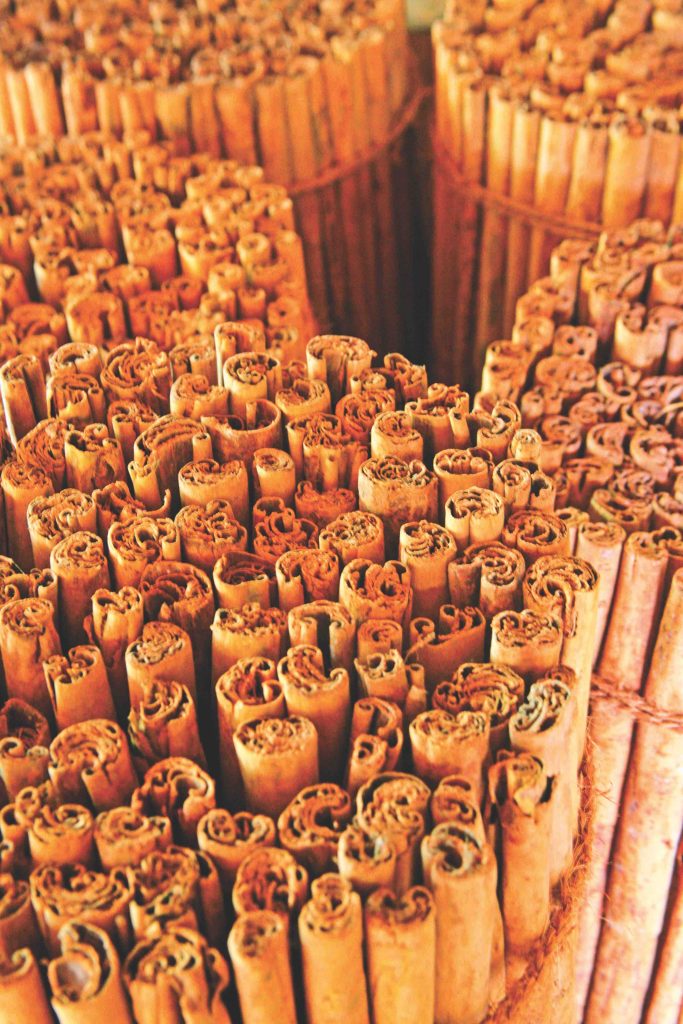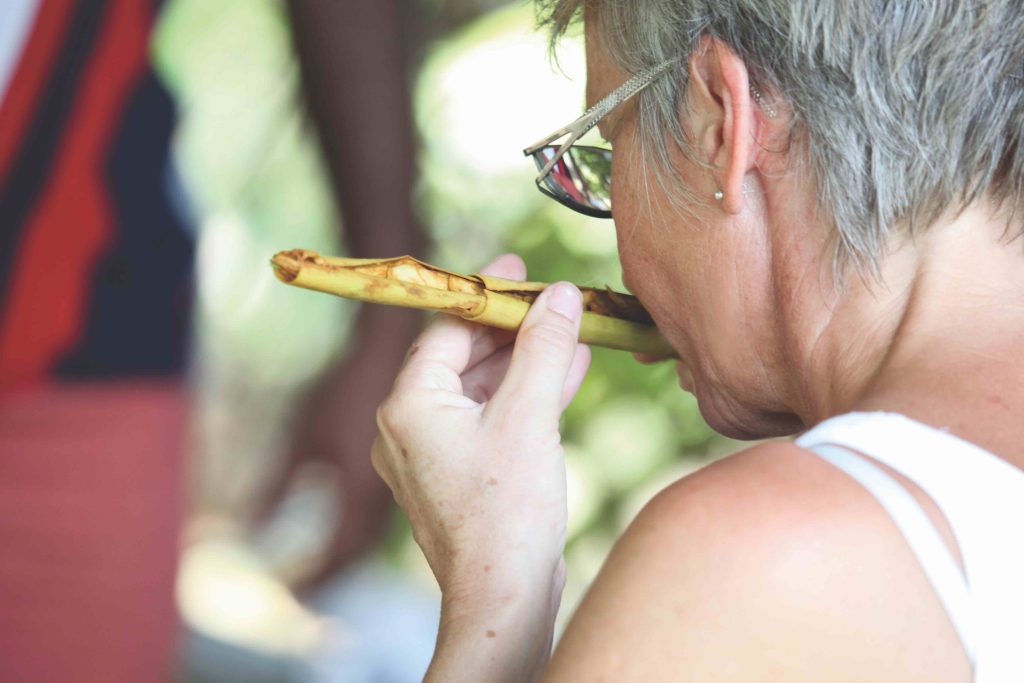
The southern districts of Galle and Matara are the largest cinnamon
producing districts in the island.

The famous Ceylon Cinnamon with its unmatched quality is well-liked
by people all around the world.
Ceylon Cinnamon possesses a coterie of traits. Its aroma is so distinct that it varies between warm and sharp. A bit heady, too. Its taste is even more compelling, vacillating between sweet and savory. Ceylon Cinnamon has a commanding presence in the world because it stands alone as its only kind, dominating the food universe in the home and in the hands of Michelin-starred chefs. It is a wonder spice revered by the ancients, from royalty to nobility, who sought cinnamon for therapy and aroma. Ceylon Cinnamon lights up the food and the mood. Call it the panacea for many ills.
Words Jennifer Paldano Goonewardane.
Photography BT Images.
Busy dockworkers loading cinnamon onto moored vessels while merchants bartered their wares in exchange for the priced spice of the isle would have been the scenes of yore on the shores of the island. The vibrant marketplace brought a sundry of out-of-towners in the form of envoys, dealers, and explorers who sought to lay hands on the precious merchandise. At the height of European expansionism, cinnamon was beloved by the conquistadores. The island became so well-known for the spice that it was called the ‘Isle of Cinnamon’.
On the island, our kings waged wars to expand their territories to claim the lands that bore the precious trees. This was long before coffee and tea made their advent. It was when cinnamon reigned supreme as the island’s first export commodity and was sought by ancient Egyptians, the Arab caravans, and the Romans, who paid heftily, historians claiming that they spent as much as the Roman equivalent of eight pounds sterling per pound for the prized spice several centuries ago. It had the leverage to unseat kings who bartered cinnamon to keep the crown. Two hundred and fifty thousand pounds of cinnamon in exchange for one’s life was how precious a spice it was in the sixteenth century. And that deal, if we call it so, marked the island’s first international trade treaty in agriculture with the Portuguese. The Dutch, it seems, had it easy too when later, in the eighteenth century, King Keerthi Sri Rajasinha of the Kandy Kingdom signed the Hanguranketha Treaty, acknowledging the Dutch imperial authority and agreeing to accede his right to engage in foreign trade while granting them control over the country’s cinnamon industry.
Ceylon Cinnamon owes its glory and spotlight to the hands that craft it from a branch to a fine quill. Its processing is a work of art, which demands more than half of its preparation time, and skill determines quality.

Ceylon Cinnamon has its own art of production.
Ceylon Cinnamon (Cinnamomum Zeylanicum) is described as an evergreen perennial hardy plant native to Sri Lanka. It is also described as True Cinnamon to distinguish it from its pretentious contender, Cassia, which is grown in Southeast Asia. Sri Lanka is the largest supplier of True Cinnamon in the world.
Therefore, Ceylon Cinnamon is one of its kind, and it was aptly named Mother of Cinnamon in tribute to its authenticity. The five main products from the cinnamon plant are quills, featherings, chips, bark oil, and leaf oil. Sri Lanka has maintained its unique standalone position globally as the only country that processes cinnamon quills, making up ninety percent of the industry. The average yield in Sri Lanka is about four hundred and seventy kilograms of quills per hectare. Based on the pungency of the bark, growers have recognized several True Cinnamon types, which range from sweet, bitter, savory to sour, while cinnamon quills are graded according to the fineness of the bark.
Merchants even maintained trade secrets regarding cinnamon. It is written how Arab traders concealed the source of their cinnamon, promoting the Horn of Africa as the ‘Cinnamon Region,’ thereby maintaining their hegemony and commercial advantage in the trade. Modern history has been no different. The Orient’s rich spices and natural resources would have featured large when the age of exploration began in the mid-fifteenth century. This saw adventurous men encouraged by profitable trade opportunities embarking on new discoveries.
One can deduce that Ceylon Cinnamon’s potential for prosperity was well-known by then and thus brought the Portuguese to the island’s shores in 1505. They soon dived into harvesting cinnamon by taking over the collection of cinnamon growing in the wild. Shortly, the Portuguese had taken control of the industry and the trade. Several interesting historical snippets reveal how the Ceylonese living on Portuguese-captured territory had to forfeit a specified amount of cinnamon to their foreign landlords yearly.
Interestingly, the local industry was controlled by one individual – the Portuguese Captain in Colombo. He could buy and sell cinnamon and decided who could and could not trade in the spice. Hence, everyone else who wished to trade in cinnamon had to be influential and affluent. Licenses were issued to ease the process, but they were too numerous that the trade eventually suffered with declining earnings, a fact revealed in a communique sent by the Portuguese Captain in Colombo to his king. In response to this conundrum, in a treaty between the Portuguese Governor of Goa, Manual de Sousa, and the Captain of Colombo, Simone de Brito, the latter agreed to sell one-third of his cinnamon purchases to the Portuguese government, which was sold at the Indian Port of Cochin. The income that de Brito made this way was used to cover the expenses of the Portuguese Fort in Colombo. That treaty signed in 1590 had lasted until 1606. However, the exploitation of cinnamon growers and peelers increased in Ceylon, and the Portuguese authorities, in a bid to contain the fallout, in 1613, issued a decree banning its elites from using cinnamon growers and peelers for personal profit. Henceforth, declared the Lisbon authorities, cinnamon must be produced solely for the Portuguese government.
Then sailed the Dutch ships that jockeyed for regional power and dominance. With their gutsier approach to building a robust trade empire, they unseated the Portuguese and saw them wrestling control of the cinnamon trade from their predecessors in the seventeenth century. The Dutch were the first to establish cinnamon plantations, which they did between 1765 and 1770 in Negombo, located on the island’s west coast, and went on to enjoy a trade monopoly. Some credit Dutch Governor Wilhelm Falk for establishing the first ever systematic cinnamon plantation in 1767, beginning from Colombo and growing northwards towards Negombo, the Dutch taking things into their hands when the island’s king obstructed them from collecting the cinnamon bark from the wild. By the time the British came along in the nineteenth century, cinnamon plantations had grown to nearly one thousand six hundred hectares. However, it marked a shift in interest as coffee and tea became primary crops of economic significance.

The aroma of cinnamon is soothing and therapeutic.
Events in history testify to cinnamon’s greatness, but its distinction is wrought at the hands of men and women who cut, peel, and prepare the spice known as Ceylon Cinnamon. Today, Ceylon Cinnamon plantations have spread beyond the suburbs of Colombo to the southern districts of Galle and Matara, which have emerged as the biggest cinnamon-producing districts in the country, accounting for forty-one percent and twenty-one percent, respectively, of the total cultivated extent. Ratnapura district is also a cinnamon-growing region in the southwest of Sri Lanka, with a cultivated area of fourteen percent. Hambantota and Badulla districts in the country have also emerged as cinnamon-growing regions of late, with minor areas in the south and northwest continuing to produce cinnamon as they did from colonial days.
Ceylon Cinnamon owes its glory and spotlight to the hands that craft it from a branch to a fine quill. Its processing is a work of art, which demands more than half of its preparation time, and skill determines quality. What gives a mere brown stick value is what goes into perfecting it, from stalks that are carefully scraped off their outer layer with a one-sided pointed knife to rubbing the bark with a brass rod to loosen it from the wood are not hurried jobs. They require patience and precision because the best cinnamon is wrought at the hands of the dedicated crafter. The final product is carefully separated from the wood by making a longitudinal slit along the stick and then cautiously steering the knife between the bark and the wood to separate them without causing damage.
The secret to good cinnamon is not about the time spent peeling, cleaning, and undoing the bark from the wood. Those matter too, but how the peelers apply themselves to the task, the passion for thoroughness, care, and precision ensures that its properties are retained and brought out in their finest form. A skilled individual can prepare three kilograms a day. The best and the most aromatic cinnamon is produced manually to this day. Like every age-old industry has an art of production, Ceylon Cinnamon has its own. Traditionally, the cleaned sticks are air-dried indoors on rope strands, and then several sticks are connected by rolling together to make forty-two-inch pipes with chips filled in between. The quills are disinfected, bleached in smoke, packed into bundles, and sewn into gunny bags. Interestingly, cinnamon quills are not homogenous; in their refined state, they contain variances and are thus graded according to thickness and extent of tint.
Cinnamon is a vibrant industry today, and Ceylon Cinnamon stands unmatched globally. Those involved in growing and processing are of different scales, but they all follow time-tested and time-honored rules of production that have ensured its exclusivity. Although cinnamon peeling is time-consuming, customarily, it used to be a family-centered activity when the primary peeling season from May to September coincided with the period when the paddy fields weren’t being cultivated. Researchers record a minor season in January as well. Interestingly, each season follows one of the annual monsoons to ensure sufficient moisture to remove the bark easily. Still, some peeling will occur throughout the year, especially in March, before the country’s annual national New Year in April, when locals spare no expense to celebrate it grandly. For that matter, a stock of cinnamon would come in handy in any financial emergency. After all, there was a reason for cinnamon’s reign as the queen of spices from time immemorial. To every family that owned the trees, cinnamon sticks were worth a fortune and their stock of liquid cash.



